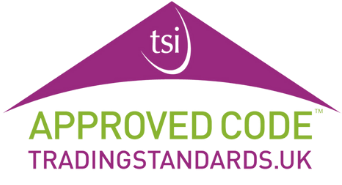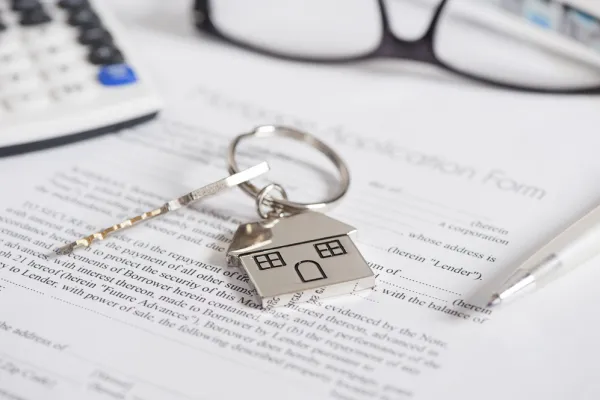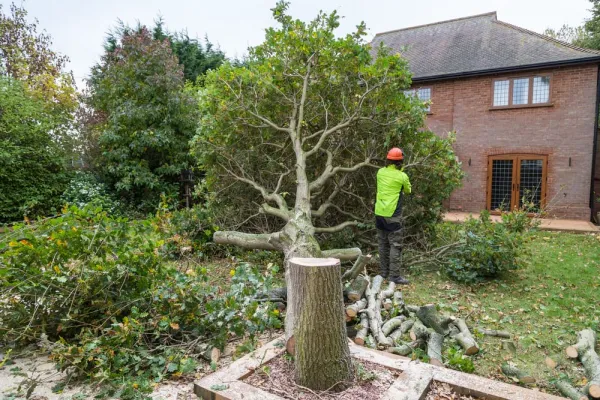Trees are a common source of disagreement for UK homeowners.
Laws exist to state what you can and can’t do with a tree close to your house or blocking out light.
Read on to find out the common practices for when this situation arises.
Are there legal limits to the height of trees near houses?
No. There is no maximum height that a tree is allowed to reach in the UK.
No law prohibits it from reaching a certain height, even if it’s close to a house.
However, you can ask your neighbour how they intend to maintain it. You can ask your local council to investigate the matter if your neighbour is uncooperative.
They’ll look at the situation and possibly order someone to trim their tree, if necessary.
You are also entitled to trim the tree if it crosses your side of the property boundary (check your title deeds if you need clarification).
You should get proof of it crossing over the line before doing that. If you trim part of the tree on your neighbour’s side, you could be breaking the law.
Can I force my neighbour to cut down a tree?
You can handle the situation if the tree’s roots are on your side of the boundary line. But they are responsible if it’s rooted in their property’s garden.
If you’re concerned about a neighbour’s tree, you can report it to the council. Reasons you might be concerned include:
- It could fall over
- It’s blocking out sunlight
- You suspect it’s diseased
- It’s leaning on your fence.
The council will visit your property to assess the situation. They might then ask the owner to make it safe or deal with it themselves.
Do I have to look after the trees on my property?
Yes. You are responsible for everything on your land. This includes trees.
Your top priority is the safety of anyone who might be affected by your tree.
This includes you, your neighbours, and passers-by on the tree. If you suspect the tree is diseased or has grown too tall, it’s your responsibility to pay an expert to sort it.
Protected trees
If your tree is protected, you should also contact the local council before completing certain activities.
You can’t cut down certain types of protected trees in the UK.
It’s your responsibility to be aware of any animals that are nesting in the tree. If these are protected species, you often can’t disrupt their homes.
What happens if a tree is a problem in a conservation area?
You must contact your local council in this situation. They will arrange to visit you in-person and inspect the tree.
You’ll have to explain your concern and what you intend to do about it. They may approve your plan or ask you to amend it slightly.
Alternatively, they may insist on doing the work themselves.
Failure to comply with any rules they’ve set out could cause you to be fined or even imprisoned.
What happens if a tree leans over the property boundary?
You have a right to trim anything that’s on your side of the boundary line. Get photographic evidence of this in case a dispute arises.
Who is responsible if a neighbour’s tree falls on my property?
This is a complicated question. In most cases, your neighbour will be responsible.
Although not always. You should get personalised advice from a legal expert.
In the meantime, home insurance can cover this issue. Check with your provider on policies covering this issue.
Do I always need permission to cut down a tree?
No, not always. If the tree is solely on your land, then you have the right to cut it down.
Just make sure that it doesn’t have a ‘Tree Preservation Order’ on it, nor is it a protected type of tree.
In these cases, you’ll need to contact your council, which will visit you to review the situation.
Will trees affect the value of my property?
In some cases, yes.
A tree can improve your property’s value if buyers think it’s beautiful. Or perhaps it holds a function, such as being suitable for a treehouse.
But a tree might also decrease your property’s value. This could be because it’s very close to your property roof.
Or maybe it requires extra maintenance, which your buyer doesn’t want to do.
What if I find out a tree is diseased after I buy a house?
You should contact the council about getting it inspected. They can approve the right course of action.
You may also want to take action against the previous owners, if they knew about it when they sold the house, but didn’t tell you.
Alternatively, you may choose to take action against a surveyor if they inspected the house and failed to spot it.
It depends on the situation. Speak to a solicitor for guidance on your rights.
















